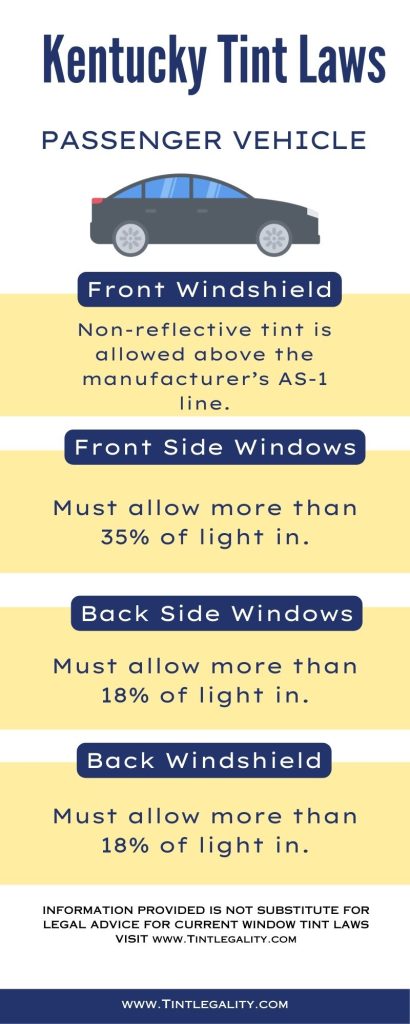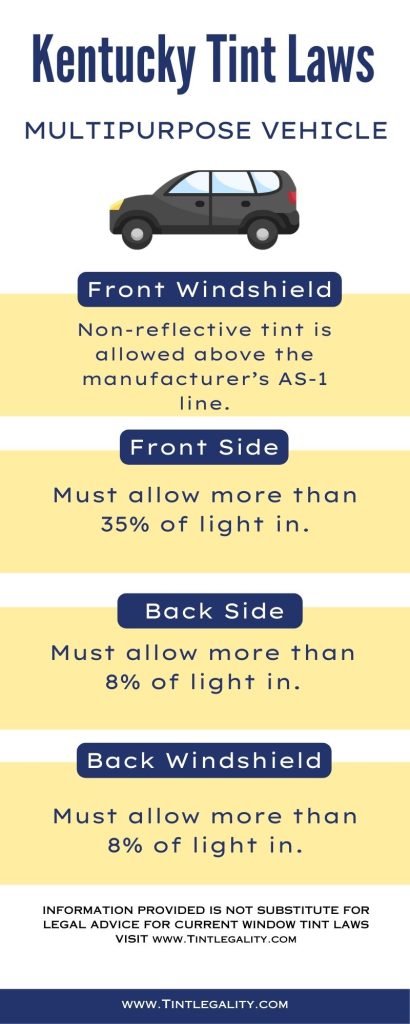Kentucky tint laws were enacted in 1994 and have been updated over the years.
In this article, we’ll go over the regulations regarding window tint in Kentucky, including the allowed tint percentages, color restrictions, medical exemptions, and penalties for non-compliance.
Regulations Regarding Window Tint in Kentucky
Kentucky tint laws apply to all cars registered in the state, including out-of-state vehicles that are temporarily in Kentucky.
Here are the regulations regarding each window on a car:
| Window | Tint Percentages | Reflectiveness | Color Restrictions | Side Mirrors |
|---|---|---|---|---|
| Windshield | 70% visible light transmission | Not more than 25% reflective | No red, blue, or amber tint | N/A |
| Front Side Windows | 35% visible light transmission | Not more than 25% reflective | No red, blue, or amber tint | N/A |
| Back Side Windows | 18% visible light transmission | Not more than 25% reflective | No red, blue, or amber tint | Required if rear window is tinted |
| Rear Window | 18% visible light transmission | Not more than 25% reflective | No red, blue, or amber tint | Required if rear window is tinted |
Windshield
The windshield must allow at least 70% of visible light to pass through, meaning that only a very light tint strip is allowed at the top of the windshield.
This applies to the area that extends from the top of the steering wheel up to two inches below the top of the windshield.
Front Side Windows
The front side windows must allow at least 35% of visible light to pass through.
This means that the tint can’t be too dark and that law enforcement officers can easily see into the car.
The tint can’t be more than 25% reflective.
Back Side Windows
The back side windows and rear windows can have a darker tint than the front side windows.
They must allow at least 18% of visible light to pass through. The tint can’t be more than 25% reflective.


Additional Regulations
Reflection
Kentucky tint laws regulate the amount of light that can reflect off the window’s surface.
The tint can’t be more than 25% reflective on any window except for the front side windows, where it can’t exceed 25% reflectiveness.
Medical Exemptions
Kentucky allows medical exemptions to its tint laws. Individuals with a medical condition that requires the use of tinted windows can apply for an exemption.
The exemption is valid for up to two years and must be renewed if the medical condition persists.
Color Restrictions
Kentucky does not allow certain colors of window tint. Red, blue, and amber tints are not allowed on any window.
Other colors are allowed as long as they meet the state’s visibility requirements.
Side Mirrors
If the rear window is tinted, the vehicle must have side mirrors that provide a view behind the car.
Exceptions to Legal Limits
There are a few exceptions to Kentucky’s legal limits.
For example, vehicles used for law enforcement purposes or those with manufacturer-installed tint do not need to comply with Kentucky’s tint laws.
Additionally, vehicles with a GVWR (gross vehicle weight rating) of more than 10,000 pounds are not subject to the state’s tint laws.
Penalties for Breaking the Law
Fines
If a driver is caught with illegal window tint, they can be ticketed and fined. The fine amount varies depending on the county, but fines can range from $20 to $200 for the first offense.
First Conviction
For a first conviction of violating Kentucky’s tint laws, the driver may be fined and required to remove the tint. The driver may also be required to present their vehicle for inspection to verify that the tint has been removed.
Second Conviction
A second conviction for violating Kentucky’s tint laws can result in a fine and mandatory tint removal. Additionally, the driver’s license may be suspended for up to six months.
Third Conviction
For a third conviction, the driver may face a fine and mandatory tint removal. The driver’s license may also be suspended for up to one year.
Other Penalties
If a driver with illegal window tint is involved in an accident, their insurance company may not cover the damages.
Additionally, law enforcement officers may use illegal tint as probable cause for a traffic stop and search of the vehicle, which could lead to further penalties if illegal substances or items are found.
Penalties for Non-Compliance
If a driver does not comply with the court order to remove the illegal tint, they can face additional penalties.
These penalties can include fines, license suspension, or even jail time.
Kentucky tint laws regulate the amount of tint allowed on car windows to ensure the safety of drivers and passengers on the road.
It’s important for car owners to understand these regulations to avoid getting ticketed or fined.
While legal tint can provide benefits like added privacy and UV protection, it’s important to make sure that the tint meets Kentucky’s regulations.
By following these regulations, car owners can enjoy the benefits of tint while staying compliant with the law.
What is the minimum visible light transmission allowed for front-side windows?
35%.
Can medical exemptions be granted for tinted windows?
Yes.
Are there color restrictions for window tints in Kentucky?
Yes, no red, blue, or amber tint.
What are the penalties for breaking Kentucky tint laws?
Fines, tint removal, license suspension, and non-compliance penalties.
Are there benefits to legal window tint?
Yes, added privacy, UV protection, and cooler interior temperatures.
How can I get my car tinted legally in Kentucky?
Find a reputable installer who can ensure your tint meets state regulations.
References:
https://en.wikipedia.org/wiki/Kentucky
https://www.kentucky.gov/Pages/home.aspx
https://law.justia.com/codes/kentucky/2018/chapter-189/section-.110/